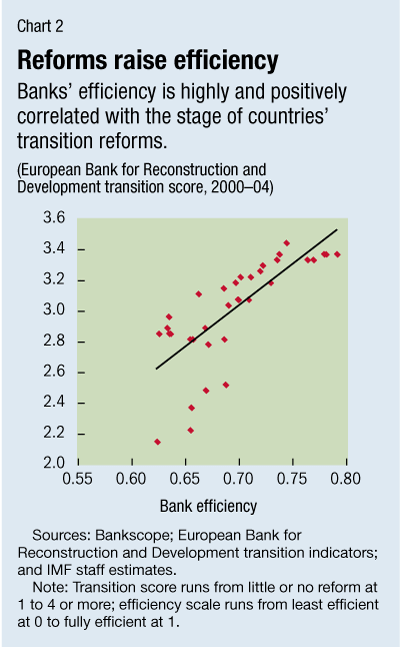BANKING IN TRANSITION ECONOMIES

Typical street scene in Santa Ana, El Salvador. (Photo: iStock)
IMF Survey: Southeastern Europe's Banks Need to Boost Efficiency
April 25, 2008
- Banks' costs higher in southeastern Europe than in comparable economies
- Higher costs reflect bank inefficiency arising from slow reforms, poor practices
- Costs can be cut by building institutions, exposing banks to more competition
High intermediation costs among banks in southeastern Europe are hampering economic development in the region.

Bank offices in Bucharest, Romania: southeastern Europe's high bank costs arise partly from inefficiency (photo: Daniel Mihailescu/AFP/Getty)
The costs for these banks of intermediation—that is, transforming deposits from one set of customers into loans for another—need to be lowered more rapidly toward industrial-country levels.
IMF studies of the region's financial sector show numerous institutional weaknesses that are costly for banks. These weaknesses reduce the incentives for banks to expand the scope of their activities and broaden their customer base. IMF staff have been closely monitoring developments in the banking sectors in southeastern Europe, focusing on the institutions' soundness and their ability to facilitate economic development.
IMF Financial System Stability Assessments (FSSAs) are designed to help countries identify and remedy weaknesses in their financial systems and thus enhance their resilience to macroeconomic shocks and cross-border contagion. FSSAs have been performed for most southeastern European countries, and updates are under way for Bulgaria, Croatia, Macedonia, and Romania.
Importance of financial deepening
Data suggest that high costs of financial intermediation in southeastern Europe arise in part from the inefficiency of banks. High costs of financial intermediation are often cited as a concern for developing and emerging market countries, as they hamper their financial deepening—providing more banking services to more people—which is essential for economic development.
A number of European transition economies, including the Czech Republic, Estonia, and Lithuania, have been able to avoid this problem by lowering intermediation costs to industrial country levels. However, this has not been the case in southeastern Europe (SEE)—Albania, Bosnia and Herzegovina, Bulgaria, Croatia, Macedonia, Romania, and Slovenia—although a decline in intermediation costs in Slovenia accelerated after it joined the European Union in 2004.
Financial intermediation costs in the SEE countries have been declining only very gradually, and are still well above those in industrialized and more advanced transition economies. Banks were able to narrow their net interest margins in 2000-04, as loan-loss provisions declined, thanks to the improved quality of lending portfolios. Overhead costs, despite some decline, still exceed those of Austrian banks, which are a useful benchmark given their involvement in SEE countries
Cross-country comparison
Low efficiency ratios and earning assets per employee suggest that SEE banks are inefficient. Efficiency ratios—total assets as a share of overhead costs—are low even in Slovenian banks, the most advanced among SEE countries. Earning assets per employee are less than half of those in Austrian banks. As several FSSAs have pointed out, banks in SEE countries have low risk tolerance and prefer to maintain high precautionary balances.
We can also measure the efficiency of banks as the distance between their actual output and what they could produce if they were at the production frontier, for a given level of inputs, using a scale of 0 (least efficient) to 1 (fully efficient bank). Banks' output is measured in terms of the value of loans, while inputs include deposits, capital, and labor.
Estimates show that SEE banks have become more efficient, but, on average, they are still less efficient than Austrian banks. This might be explained by country differences and banks' operational practices.
Banks in more advanced SEE economies—Slovenia, Croatia, Romania, and Bulgaria—are more efficient and were able to reduce intermediation costs faster than the rest of the sample (see Chart 1).

Banks' efficiency is also highly and positively correlated with the stage of countries' transition reforms, as registered by the EBRD transition indicators (see Chart 2).

Foreign banks, on average, are more efficient than domestic banks, suggesting better operational practices at foreign banks. In most SEE countries—Bosnia and Herzegovina, Croatia, Slovenia, and Macedonia—foreign banks' efficiency improved faster than that of domestic banks, and, more generally, banks' efficiency improves with the rising share of foreign banks in the banking system.
Any role for government?
Governments can facilitate the reduction in financial intermediation costs by acting on two fronts:
• Changing the business environment through institution-building. The findings of the FSSAs for SEE countries point to numerous institutional weaknesses—inadequate credit information, weaknesses in judicial systems and in corporate governance—which are costly for banks and raise their risks.
• Exposing banks to greater competition. Allowing entry of foreign banks and keeping a level playing field promotes competition between foreign and domestic banks, encouraging them to adopt modern banking practices. The development of nonbank intermediaries and capital markets could strengthen competition in the banking sector. Finally, the direct access of businesses to foreign financial markets might further enhance competition in the banking sector, as has been the case in Slovenia.
Comments on this article should be sent to imfsurvey@imf.org







